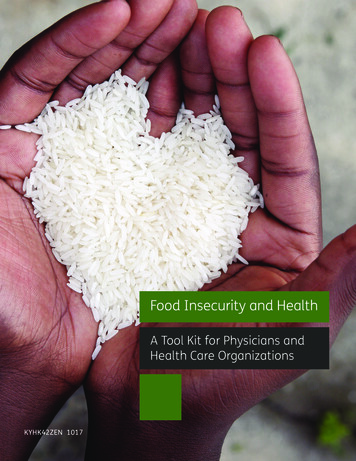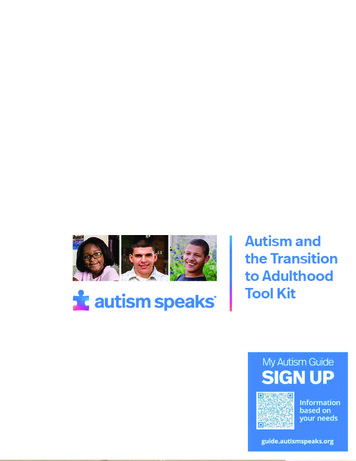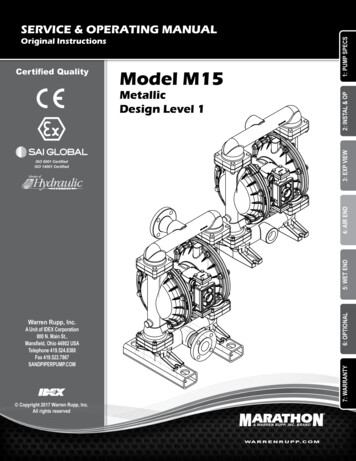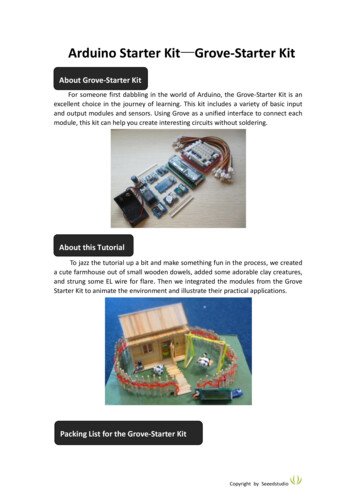
Transcription
Food Insecurity and HealthA Tool Kit for Physicians andHealth Care OrganizationsKYHK42ZEN 10171
IntroductionFood insecurity is an importantbut often overlooked factoraffecting the health of asignificant segment of theAmerican population. In theUnited States, 1 in 8 peoplestruggles with hunger and no onecan thrive on an empty stomach.To raise awareness and to offersuggestions for how healthcare professionals might treatfood insecurity in their patients,Humana partnered with FeedingAmerica, the largest domestichunger-relief charity in the UnitedStates, to develop this toolkit. Wehope you find it informative anduseful in your effort to provide thebest possible care to your patients.If you have feedback concerningthis toolkit, we would loveto hear it. Please send yourideas or questions to us atBoldGoal@humana.com.2
ContentsSection 1Food insecurity and health. . . . . . . . . . . . . . . . . . . . . . . . . . . . . . . 4Section 2How to address food insecurity . . . . . . . . . . . . . . . . . . . . . . . . . . . 9Section 3Connecting patients tocommunity food resources. . . . . . . . . . . . . . . . . . . . . . . . . . . . . . 20Section 4Working with food banks and othercommunity organizations. . . . . . . . . . . . . . . . . . . . . . . . . . . . . . . 25Section 5Case study: South Florida . . . . . . . . . . . . . . . . . . . . . . . . . . . . . . . 27Section 6Resources and other considerations . . . . . . . . . . . . . . . . . . . . . . 293
SECTION 1:Food insecurityand health4
Section 1 Food insecurity and healthWhat is food insecurity?Food insecurity is defined by the U.S. Department of Agriculture (USDA)as “limited or uncertain availability of nutritionally adequate andsafe foods or limited or uncertain ability to acquire acceptable foodsin socially acceptable ways.” Food insecurity is a situation in whichhouseholds lack access to enough nutritious food for a healthy,active life.As the health care sector seeks to better understand and address socialdeterminants of health, food insecurity is emerging as a key factor forchronic disease – and one that health care providers can help address inorder to improve health outcomes.What should I know about food insecurityin my community?Food insecurity isn’t just an individual problem; it’s an issue thataffects whole households. While food insecurity and poverty gohand in hand, many factors lead to a family being food insecure,including unemployment, scarcity of household assets and certaindemographic factors.Nationally, 1 in 8 (12.3 percent) of households is food insecure,although prevalence varies by community. Food insecurity exists inevery county, parish and congressional district in the United States.(See figure 1.) While there is no single face of food insecurity, it is moreprevalent when households: Include children Are headed by a single woman Are African American or Hispanic H ave income lower than or equal to 185 percent of the FederalPoverty Line (FPL) thresholdThere also is an emerging trend of food insecurity in households headedby grandparents1.Coleman-Jensen, A., Rabbitt, M.P., Gregory, C., and Singh A. 2017. Householdfood security in the United States in 2016, ERR-237, U.S. Department ofAgriculture, Economic Research Service.15
Section 1 Food insecurity and healthFig. 1. Distribution of food insecurity in the U.S.Source: Feeding America, “Map the Meal Gap (2015),” Map.feedingamerica.org Feeding America 2017Food programs, such as the Supplemental Nutrition Assistance Program(SNAP, formerly known as food stamps); the Women, Infant, andChildren’s Program (WIC); and the National School Lunch and SchoolBreakfast programs, help feed many low-income families across thecountry. That means that many households under the Federal PovertyLine are food secure, while those with slightly higher incomes, butwithout access to other support, may be food insecure.Food insecurity can be both episodic and cyclical. For families with limitedhousehold assets, an emergency expense, such as medical bills or carrepair, can cause food insecurity. Food insecurity also can occur duringtimes of the year when income is typically lower, or seasonally, whenexpenses are higher. For example, food insecurity can increase during thesummer, when children are out of school and lose accessto school breakfast and lunch programs. In colder climates, it can bemore of a challenge in the winter, when heating expenses increase.6
Section 1 Food insecurity and healthHow does food insecurity impact health?Unhealthy diets amplify the negative outcomes experienced byfood insecure individuals. The combination of an unhealthy dietand food insecurity leads to:U.S. Departmentof AgricultureEconomic ResearchService. 2017.Food insecurity,chronic disease,and health amongworking-age adults.Impaired growthin childrenMore chronicdisease for adultsHEALTH IMPLICATIONSHigherhealthcare costsMissed work daysand lower incomeFINANCIAL IMPLICATIONSConsequently, many studies of mixed populations (including children, adultsand older adults) have shown a correlation between food insecurity andpoor health outcomes. Food insecurity is linked specifically to these healthproblems: H igher levels of chronic disease,such as diabetes, hypertension,coronary heart disease (CHD),hepatitis, stroke, cancer, asthma,arthritis, chronic obstructivepulmonary disease (COPD) andchronic kidney disease (CKD)3,4 Medication non-adherence5 Poor diabetes self-management6 H igher probability of mental healthissues, such as depression7 H igher rates of iron-deficientanemia8 M ore hospitalizations and longerin-patient stays92Journal of the American Dietetic Association.2010. Position of the American Dietetic Association:food insecurity in the United States. Holben D. Sept:110(9):1368-77.Seligman, H., Jacobs, E., Lopez, A., Tschann, J.,Fernandez, A. 2012. Food insecurity and glycemiccontrol among low-income patients with Type 2diabetes. Diabetes Care 35 (2): 233–8.Irving S.M., Njai R., Siegel P. 2009. Food insecurityand self-reported hypertension among Hispanic,black, and white adults in 12 states, behavioral riskfactor surveillance system. Preventing ChronicDisease. 2014; 11:E161.Silverman, et al. 2015. The relationship betweenfood insecurity and depression, diabetes distressand medication adherence among low-incomepatients with poorly-controlled diabetes. Journalof General Internal Medicine, 2015, Volume 30,No. 10, Page 1476.3Seligman, H. K., Bindman, A., Vittinghoff, E., et al.2007. Food insecurity is associated with DiabetesMellitus: Results from the National Health Examination and Nutrition Examination Survey (NHANES)1999-2002. Journal of General Internal Medicine 22(7): 1018–23.4Ippolito, M., Lyles, C. Prendergast, K., Seligman,H. 2016. Food insecurity and diabetes selfmanagement among food pantry clients; Journalof Public Health Nutrition. 20(1): 183-189.567Eicher-Miller, H.A., Mason, A., Weaver, C. M., et. al.Food insecurity is associated with iron-deficiencyanemia in US adolescents. American Journal ofClinical Nutrition. 2009; 90 (5): 1358-1371.8Seligman, H., Bolger K., Guzman A., et al. 2014.Exhaustion of food budgets at month’s end andhospital admissions for hypoglycemia. Health Affairs.33(1): 116-123.97
Section 1 Food insecurity and healthFor instance, seniors who are food insecure have: H igher rates of chronic conditions. They are 50 percent more likely tobe diabetic, 14 percent more likely to have high blood pressure, nearly60 percent more likely to have congestive heart failure or experiencea heart attack and twice as likely to have asthma. P oorer general health. They are 30 percent more likely to report at leastone activities-of-daily living (ADL) limitation and twice as likelyto report fair or poor general health. Three times higher prevalence of depression A diminished capacity to maintain independence while aging10Given these correlations, it is not surprising that patients who are foodinsecure have higher health costs. A 2017 study showed that the averagecost difference between food insecure and food secure individuals was 1,863, and it was much greater for individuals with diabetes ( 4,413)and heart disease ( 5,144).11Using the Centers for Disease Control and Prevention’s (CDC) HealthyDays survey,12 a 2016 study by Humana found that patients who arefood insecure have nearly twice as many unhealthy days (27) eachmonth as food secure patients (14.2).13Simply put: Food insecurity is prevalent, widespread and detrimental tohealth in certain at-risk populations. Physicians/clinicians can help addressthe issue by screening for food insecurity and connecting patients toavailable resources and interventions.Zaliak, J. P., Gundersen, C. 2014. The health consequences of senior hungerin the United States: Evidence from the 1999-2010 NHANES.10Berkowitz, S. A., Basu, S., Meigs, J., Seligman, H. 2017. Food insecurity andhealth care expenditures in the United States, 2011–2013. Health Serv Res.doi:10.1111/1475-6773.12730.11Healthy Days is a self-reported, health-related quality-of-life measure withstrong correlations to clinical health, health care utilization and costs. It can beleveraged in two- or four-question formats. More information on Healthy Dayscan be found in Section II. How to Address Food Insecurity, Page 19.12McGrath E., Renda A., Eaker E., et al. 2017. Food insecurity in primary carepatients. Poster presentation at 2017 Art & Science of Health PromotionConference. Colorado Springs, Colorado.138
SECTION 2:How to addressfood insecurity9
Section 2: How to address food insecurityHow can physicians/clinicians help addressfood insecurity?Physicians and clinicians can play a critical role in identifying andaddressing patient food insecurity. By screening for social determinantsof health, they can easily add food insecurity to the clinical dialogueand make referrals to community resources if needed.The food insecurity screening and referral process consists of five steps:1. Identifying patients living in food insecure households2. Connecting patients with proper resources3. Considering clinical needs that result from food insecurity4. Following up with patients at their next office visit5. M easuring the impact of food insecurity intervention(s) onpatients’ food insecurity status and healthSource: Feeding America, “Tackling food insecurity,” feedingamerica.org. Feeding America 201710
Section 2: How to address food insecurityHow can you screen for food insecurity?Annual data on food insecurity is collected by the USDA throughits 18-question Household Food Security Survey. Two of the surveyquestions have proven to be effective (97 percent sensitivity and 83percent specificity)14 when screening for food insecurity in a clinicalsetting. Known collectively as the Hunger Vital Sign, the two questionsenable clinicians to assess the food needs of a patient and theirhousehold quickly. The questions are:Hunger Vital Sign Two-Question Screening for Food Insecurity “ Within the past 12 months we worried whether our food wouldrun out before we got money to buy more.” Was that often true,sometimes true, or never true for you/your household? “ Within the past 12 months the food we bought just didn’t lastand we didn’t have money to get more.” Was that often,sometimes, or never true for you/your household?A response of “sometimes true” or “often true” to either or bothquestions should trigger a referral for food security support.Screening for food insecurity generally takes one minute or less.It should not be done more frequently than once every 30 days.Photo courtesy ofFeeding America.Hager, E., Quigg, A., Black, M., Coleman, S., et al. 2010. Development andvalidity of a 2-item screen to identify families at risk for food insecurity.Pediatrics, 126(1), e26-e32.1411
Section 2: How to address food insecurityWhat do you need to know about screeningfor food insecurity?To avoid the stigma and embarrassment that can be associated withfood insecurity, screening should be conducted in a private setting andby a trusted source within the clinic. You should also avoid making thepatient feel like you are singling them out — one good practice isto preface screening with a statement like this:“ I ask all of my patients about access to food because it’s such animportant part of managing your health”Screenings can be conducted by the medical assistant (typically,during the social history screening), the physician or clinician or even anon-site social worker.For measurement and follow-up purposes, screening informationshould be documented in the patient’s electronic medical record (EMR).Some EMRs (e.g., Epic) have a built-in food insecurity screener, usuallyin the social-history section. Other EMRs allow for customization ofsections. See Section 6, Case Study: South Florida, on Page 27, for anexample of how a screener was built into eClinicalWorks (eCW).Photo courtesy of Feeding America.12
Section 2: How to address food insecurityWhat happens if a patient screens positivefor food insecurity?If a patient screens positive for food insecurity, the physician/cliniciancan address the food situation with the patient to ensure they haveaccess to the food and resources needed for good health and that anymedical issues arising from food insecurity are considered.As the trusted source of referrals to support good health, the physician/clinician can refer the patient to available community resources for foodaccess. Depending on the intervention selected, the medical assistant,nurse or social worker can help by identifying the best communityresources to meet the patient’s needs.When talking to a patient about food insecurity, the physician/clinicianmight consider these three steps: Acknowledge the problem Discuss the importance of food to the patient’s health Refer patient to available resourcesHere’s how the three-step approach might look in dialogue witha patient:That must be very difficult. I’m glad you shared your situation withme because the kinds of foods you eat – and don’t eat – are reallyimportant for your health.Food can be as important to managing your health as exercise andeven, in some cases, as important as the medications that you take.If you are interested, I can let you know about resources in yourarea, such as insert recommended action . Describe referral or available community resources, includingresources to assist in applying for SNAP, a senior meals program,the National School Lunch Program, WIC, a local food bank, etc. 13
Section 2: How to address food insecurityHow can you connect patients to resources?Patients who otherwise would hesitate to accept a referral to a foodpantry or meal program are more likely to comply if the referral ispresented to them as a health intervention by a trusted clinical source.Continuing the dialogue with patients during subsequent visits maydestigmatize the food insecurity issue, allowing those who initiallydecline referrals to reconsider and perhaps accept a recommendation.Depending on the community, existing local resources, access totransportation and the level of patient need in practices, health careproviders may be able to offer patients a variety of resources. Theseresources are covered in depth in Section 3: Connecting Patients toCommunity Food Resources, Page 20.How might a patient screening affect apatient’s course of treatment?Once a clinician is aware of a patient’s food insecurity status, they mightconsider if there are other aspects of care that should be addressed.Those might include: M edications. Due to food-medication tradeoffs, poor medicationadherence is a common problem for food insecure individuals.Additional education may be needed to ensure patients knowwhat to do if they cannot afford their medications, or if they areinstructed to take prescription medications with meals but cannotafford to eat three meals a day. Diabetic patients taking insulin canbenefit by knowing how to adjust their dosage if they are eatingless than normal or skipping meals. Referrals to agencies that canhelp patients apply for prescription assistance programs or discountpharmacy programs may also be useful. H ealth and nutrition education. Helping patients understand howto make better health and nutrition choices based on the optionsavailable to them from sales, bulk purchases and food pantries canmake a healthy lifestyle seem possible. Health care providers mightconsider asking registered dietitians to assist during discussionsabout nutrition.14
Section 2: How to address food insecurity M ental health. Food insecurity is linked to depression and othermental health concerns, which can be exacerbated if patients areworrying about running out of food. Talking to patients about thestress and anxiety that food insecurity may cause, and considering ifthere are options to support and improve mental health, can lead toimproved care.The Nutrition and Obesity Policy Research and Evaluation Network(NOPREN) has developed algorithms for pediatric and adult screenings.These algorithms may be valuable as you consider how to implementscreenings and referrals into your clinical workflow. The algorithms canbe found at https://nopren.org/working groups/hunger-safety-net/.Following up with patients at subsequent office visits is essential toensuring they take advantage of recommended resources. To add foodinsecurity to the patient’s problem list, use ICD-10 diagnosis codeZ59.4: Lack of adequate food and safe drinking water.How can you measure outcomes?Clinics can determine the success of food insecurity interventions byconsidering patient outcomes and clinical investment (e.g., time spentby clinical staff, clinic space required). Measurable outcomes fall intofour categories:1. What were the screening results?2. Are referrals successful at connecting patients with food resources?3. Did those resources improve the food security status of the patient?4. Did the patient’s health outcomes improve?15
Section 2: How to address food insecurityWhat were the screenings results?Health care providers can track food insecurity screening results byincluding patient screening dates, outcomes and responses in thepatient’s electronic health record.In addition to tracking a patient’s food security status, clinics can trackthe prevalence of food insecurity in the overall clinic population. Is foodinsecurity more common among clinic patients than in the communityat large? Are patients from certain demographic sectors, such as age,ethnicity, insured status and ZIP code, more likely to be food insecure?Understanding these characteristics can help clinics create referrals,relationships and programs that best meet the needs of patients andtheir families.16
Section 2: How to address food insecurityWas the referral successful?It is important to know if patients succeed in connecting with localfood resources or applying for benefit programs. During return visits tothe clinic, health care providers might ask patients about the referralsthey got and whether they followed up, if they received food and if thereferral improved their access to a more nutritious diet.Clinics working with food banks or other community organizationsmay choose to create a facilitated referral process to help connectpatients to needed resources. By having patients sign release forms,staff can get permission from them to share their name and contactinformation with food banks, local food pantries and other communityorganizations. Those resources can then contact patients to determinewhat kind of support they need (e.g., emergency food, senior meals,support for children) and refer them to the appropriate locations in theircommunity.When making patient referrals to community-based organizations,such as food pantries, food banks or Meals on Wheels, it is importantto comply with the Health Insurance Portability and Accountability Actof 1996 (HIPAA) and safeguard patient privacy. Research shows thatfacilitated referrals are much more successful than simply providinga patient with a phone number or a website. In many cases, that willrequire clinics to get the patient’s consent to share their name, phonenumber and other protected health information.To address concerns about HIPAA, Feeding America and the HarvardLaw School Center for Health Law & Policy Innovation created aresource guide with sample patient release forms and informationabout ensuring patient privacy when working with community-basedorganizations, such as food banks. Visit Food Banks as Partners in HealthPromotion: How HIPAA and Concerns about Patient Privacy Affect YourPartnership to access this resource.Keeping a list of referrals made and which patients were contacted orwent to an agency accepting those referrals can help clinics determineif referrals are successful. For more information about food resources,see Section 3: Connecting Patients to Community Food Resources, onPage 20.17
Section 2: How to address food insecurityDid the patient’s food security improve?Screening for food insecurity during every office visit can enableclinicians to know if patient food security improves. If a patient remainsfood insecure, clinicians can involve a social worker or other staffsupport to help the patient access additional help.Did the patient’s health outcomes improve?The ultimate goal of addressing food insecurity in a health care settingis to improve patient health outcomes. Improvement can be measuredby looking at these indicators: Health status of individual patientsºº Disease stabilizationºº Biometric improvements (blood pressure, body mass index,cholesterol)ºº Greater medication adherenceºº More healthy days reported Health status of aggregate clinic patients Health care resource utilizationºº Reduced emergency department visitsºº Reduced hospital admissions, readmissions, and length of stayHealth outcomes can be measured through laboratory and biometricresults, pharmacy data and self-reported measures, such as theprevalence of food and medicine trade-offs.Photo courtesy of Feeding America.18
Section 2: How to address food insecurityAdditional tools are available to measure patient health improvement,among them the Centers for Disease Control and Prevention’s (CDC)Healthy Days survey. This questionnaire is a self-reported, health-related,quality-of-life measure that can be leveraged in either a two- or fourquestion format. (See Table 1.) Healthy Days is a validated instrumentand is both a leading and lagging indicator of health that is stronglyassociated with health care utilization and costs. More information on theHealthy Days measure can be found in the reference section.TABLE 1Two-question version1. T hinking about your mentalhealth, which includes stress,depression, and problems withemotions, for how many daysduring the past 30 days wasyour mental health not good?[Options: 0 – 30 days]2. T hinking about your physicalhealth, which includes physicalillness and injury, for how manydays during the past 30 dayswas your physical health notgood? [Options: 0 – 30 days]Four-question (core) version1. I n general, would you say yourhealth is: [Options: excellent,very good, good, fair, poor]2. T hinking about your physicalhealth, which includes physicalillness and injury, for how manydays during the past 30 days wasyour physical health not good?3. T hinking about your mentalhealth, which includes stress,depression, and problems withemotions, for how many daysduring the past 30 days wasyour mental health not good?4. D uring the past 30 days, for abouthow many days did poor physicalor mental health keep you fromdoing your usual activities, such asself-care, work, or recreation?Healthy Days questions should be asked no more frequently than onceevery 30 days. Responses can trigger other screenings and assessmentsin the clinical workflow; for instance, any reported mentally unhealthydays could trigger a PHQ-2 or PHQ-9 assessment.19
SECTION 3:Connectingpatients tocommunityfood resourcesNumerous programs exist atboth the national and local levelsto provide food assistance toindividuals and families.20
Section 3: Connecting patients to community food resourcesWhat national programs are available?There are several national programs, with locations in almost everycommunity in the United States, to support access to healthy food forthose who need it. Those programs include the following:Program NameSupplementalNutritionAssistance Program(SNAP)(Formerly knownas food stamps)Women, Infants,and Children (WIC)ProgramSchool breakfastand lunchprograms forchildrenSummer MealsPrograms forChildrenMeals on WheelsBenefitsMoney to purchasefood.Websitewww.fns.usda.gov/snapThe average benefitis about 127 permonth per person.Money to purchasepre-specified foodsfor pregnant/postpartum women,infants, and childrenunder the age of 5.Nutrition educationand breastfeedingsupport alsoprovided.Free or reducedprice healthy mealsfor income-eligiblestudents of all ages.Free healthy mealsduring the summerfor students 18and under.Free or low-costhome-deliveredmeals for ww.mealsonwheelsamerica.orgFor more information about these programs, contact your local agency or theUSDA National Hunger Hotline at 1-866-348-6479. If the patient is ineligiblefor federal nutrition programs and/or if emergency food is needed, call 211to connect with the local United Way resource line.21
Section 3: Connecting patients to community food resourcesWhat local programs are available?Local responses to food insecurity depend on the organizations in thecommunity. Food banks, food pantries, mobile produce distributions,congregate meal programs, senior box programs and home- deliveredmeals are examples of programs that may be available in your community.If you aren’t familiar with any of these programs, the local Feeding Americamember food bank gives you a good resource with which to start theconversation. Visit Feeding America’s website to Find Your Local Food Bank.For more information about working with the food bank, see Section 4.Working with Food Banks and Other Community Organizations, Page 25.How can you determine the best approach toconnecting patients to resources?The time patients have with a physician/clinician is limited, so it is importantto connect them to knowledgeable, trusted sources who can assist them.An intervention also should take into account not just one possible remedy,but a combination of food resources and assistance programs.When deciding how to address patients’ food insecurity, physicians/clinicians can consider the following factors: Clinical assets, including budget, physical space and supplementalstaff members, such as social workers and registered dietitians Patient needs, cultural considerations and privacy Community resources, including public transportation, food bankservices and resources, community health workers and others whocan assistAs mentioned earlier, it is important to be aware that patients might beashamed to talk about food insecurity and reluctant to consider referralsfor assistance. Engaging patients in dialogue and framing the discussion inhealth care terms – and doing so on every visit – may help overcome theirreluctance to use referrals.22
Section 3: Connecting patients to community food resourcesSource: Feeding America, “Identifying & addressing food insecurity,”feedingamerica.org Feeding America 2017What programs can be implemented in a clinic?Clinic staff should work with local partners to assess if existing communityprograms, such as food pantries, mobile pantries, and meal programs havesufficient capacity and are geographically convenient for patients. If theyare, referrals can be made to those programs.With more detail, here are the options clinics might consider:Refer patients to existing local food access programsCreate a resource guide, similar to the national program guide on page 21of this toolkit, that lists local food pantries, mobile produce distributions,meal programs and other local organizations and activities that provideemergency and ongoing accessto food. The clinic can also workwith the local food bank toidentify a food hotline or createa direct link to a food bankrepresentative, someone whocan help patients find foodand connect with communityand governmental programsto address long-term need.Photos courtesy of Feeding America.23
Section 3: Connecting patients to community food resourcesConnect patients with long term benefitsFood boxes and food pantries serve an important role in addressingshort-term needs, but connecting patients with federal nutritionprograms can support them in the longer term. SNAP, WIC, TemporaryAssistance for Needy Families (TANF) and other programs can be vitallinks to income and nutrition security. Patients can be referred to localorganizations that can help them apply assistance.Dedicate on-site staffThe clinic may decide to dedicate a staff member to helping patientsnavigate referrals to emergency and ongoing resources and applyingfor federal and state programs. This responsibility might be shared withvolunteers from a local food bank or another community partner.What’s the bottom line?Having information about available resources at the point of care cangive patients an immediate channel to assistance and may reduce thenumber of appointments needed with outside agencies.24
SECTION 4:Working withfood banksand othercommunityorganizationsThe Feeding America networkis the nation’s largest domestichunger-relief organization workingto connect people with food andend hunger. With food banksserving every community, thisorganization is the place to go tobegin creating local partnershipsthat can support your patients.25
Section 4: Working with food banks and other community organizationsWho should you contact and how do youstart the dialogue?Health care
Healthy Days is a self-reported, health-related quality-of-life measure with strong correlations to clinical health, health care utilization and costs. It can be leveraged in two- or four-question formats. More information on Healthy Days can be found in Section II. How to Address Food Insec











